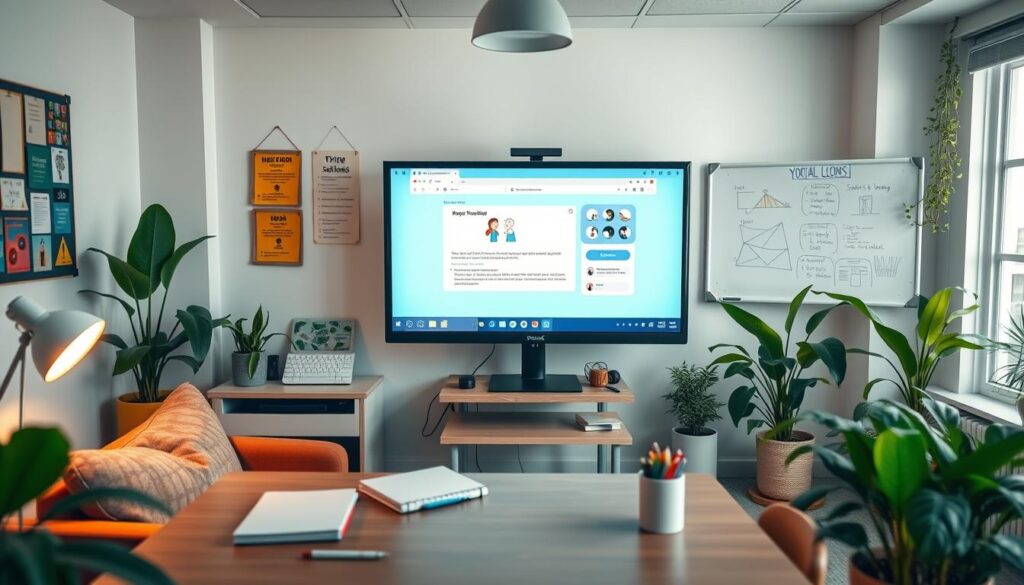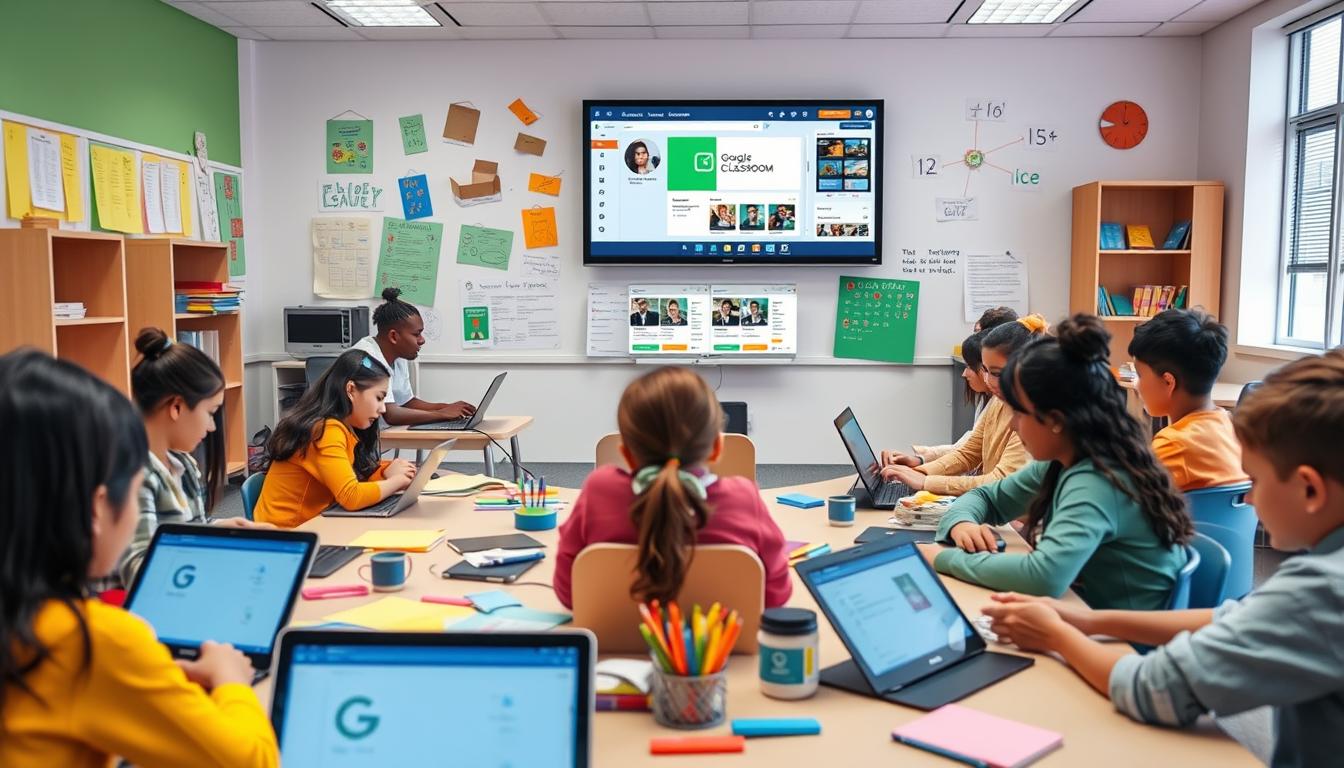In today’s rapidly evolving digital landscape, the need for efficient and accessible virtual learning solutions has never been more pressing. Enter Google Classroom 6x, a game-changing platform that’s revolutionizing the way educators and students navigate the challenges of remote and hybrid learning. But what sets this innovative tool apart, and how can it truly simplify the virtual learning experience? Discover the answers in this comprehensive guide.
What if we told you that the key to unlocking the full potential of virtual learning lies within a single, seamlessly integrated platform? Google Classroom 6x is that transformative solution, offering an unparalleled suite of features that empower educators to create dynamic, engaging, and collaborative online classrooms. From effortless assignment management to real-time feedback and communication tools, this platform is designed to streamline the virtual learning experience, making it more accessible and effective for both teachers and students.
Key Takeaways
- Google Classroom 6x simplifies virtual learning by providing a comprehensive, integrated platform for educators and students.
- The platform offers a range of features, including assignment management, feedback tools, and communication channels, to enhance the online learning experience.
- Google Classroom 6x is designed to be user-friendly and accessible, making it a valuable resource for educators navigating the challenges of remote and hybrid learning.
- The platform’s integration with other Google Workspace tools, such as Google Drive and Google Meet, further enhances its functionality and versatility.
- With its intuitive interface and powerful features, Google Classroom 6x is poised to revolutionize the way we approach virtual learning, making it more engaging, efficient, and rewarding for all involved.
Introduction to Google Classroom
In the digital age, the need for efficient and user-friendly learning management systems has become paramount. Google Classroom, a free web-based platform, has emerged as a leading solution for educators and students alike. As a comprehensive learning management system, Google Classroom streamlines the process of creating, distributing, and grading assignments, fostering a collaborative digital classroom environment.
What is Google Classroom?
Google Classroom is a robust educational tool that simplifies the management of the learning management system. Designed by Google, this platform seamlessly integrates with the Google Workspace suite, allowing teachers to leverage a range of tools, including Google Drive, Google Docs, and Google Slides, to enhance the learning experience.
Benefits of Using Google Classroom
Google Classroom offers numerous advantages for educators and students navigating the digital classroom. Some of the key benefits include:
- Improved organization and communication through centralized assignment management and real-time updates.
- Enhanced collaborative learning opportunities, as students can easily share and work on documents together.
- Seamless integration with the Google Workspace suite, allowing for a streamlined workflow and efficient resource management.
- Reduced paperwork and increased sustainability through the use of digital assignments and feedback.
- Accessibility and flexibility, enabling students to access course materials and submit assignments from anywhere, at any time.
By leveraging the power of Google Classroom, educators can create a dynamic and engaging digital classroom that fosters student success and enhances the overall learning experience.
Getting Started with Google Classroom
As educators navigate the landscape of remote instruction, leveraging powerful EdTech tools like Google Classroom can make the transition to virtual learning much smoother. Setting up your account and exploring the platform’s intuitive dashboard are the first steps in unlocking the full potential of this e-learning resource.
Setting Up Your Account
Creating a Google Classroom account is a straightforward process. Simply sign in to your Google account or create a new one if you don’t have one already. Once logged in, you’ll be prompted to create your first class or join an existing one. The setup guide will walk you through the necessary steps, ensuring you have access to all the features and functionalities of this robust e-learning platform.
Navigating the Dashboard
The Google Classroom dashboard provides a centralized hub for managing your virtual classroom. Here, you’ll find intuitive navigation tools that allow you to effortlessly toggle between your classes, access assignment submissions, and stay connected with your students. The clean and user-friendly interface makes it easy to stay organized and on top of your remote instruction responsibilities.
- Quickly access your class roster, learning materials, and communication features
- Monitor student progress and engagement through the assignment and grading tools
- Utilize the built-in calendar to stay on top of important deadlines and upcoming events
Familiarizing yourself with the Google Classroom dashboard is a crucial first step in leveraging this powerful EdTech tool to enhance your remote instruction and e-learning resources.
Creating and Managing Classes
In the virtual learning environment of Google Classroom, educators can seamlessly create and manage their digital classrooms. This intuitive platform simplifies the process of setting up and organizing your courses, fostering a collaborative learning experience for both teachers and students.
How to Create a Class
To get started, log in to your Google Classroom account and navigate to the “Classes” tab. Click on the “Create” button to begin the class creation process. You’ll be prompted to enter the class name, subject, and section details. Take this opportunity to personalize your virtual classroom and make it reflective of your teaching style and the course content.
Inviting Students to Join
Once your class is set up, it’s time to invite your students to join. Google Classroom offers a streamlined approach to this process. You can generate a unique join code that students can use to enroll in your class, or you can manually add students by entering their email addresses. This allows you to easily manage the roster and monitor your digital classroom’s enrollment.
Organizing Class Materials
- Utilize the “Classwork” tab to upload and organize your course materials, including documents, presentations, and multimedia resources.
- Create topic-based folders or modules to keep your digital classroom materials well-structured and easy to navigate.
- Encourage collaborative learning by allowing students to contribute to the class materials, fostering a dynamic and engaging virtual learning environment.
By mastering the art of creating and managing classes in Google Classroom, you can unlock the full potential of this powerful virtual learning environment, empowering your students to thrive in the digital classroom.
Assignments and Grading
In the dynamic world of online education, the seamless integration of interactive assignments and effective grading practices is crucial for fostering student engagement and success. Google Classroom, a powerful e-learning resource, empowers educators to create and manage assignments with ease, providing a comprehensive suite of tools to streamline the grading process.
Creating Assignments
Crafting engaging interactive assignments in Google Classroom is a straightforward process. Educators can leverage a variety of assignment types, including documents, presentations, and even multimedia content, to cater to diverse learning styles. With the ability to set due dates, attach files, and provide detailed instructions, teachers can ensure that students have a clear understanding of the task at hand.
Grading and Feedback Options
Google Classroom’s robust grading system allows educators to provide timely and meaningful feedback to their students. Teachers can grade assignments manually, using a point-based system or rubrics, and even offer comments to guide student progress. The platform’s online education platform features also enable the distribution of assignments and the collection of student work, streamlining the grading workflow.
Understanding the Gradebook
The Gradebook in Google Classroom serves as a centralized hub for tracking student performance. Educators can easily view individual student grades, monitor class-wide progress, and generate reports to identify areas for improvement. This comprehensive overview empowers teachers to make data-driven decisions and provide targeted support to students who may be struggling.
By leveraging the powerful features of Google Classroom, educators can create a dynamic and engaging learning environment that fosters academic growth and success. With the seamless integration of interactive assignments, robust grading tools, and a comprehensive Gradebook, the e-learning resource and online education platform offers a transformative solution for modern classrooms.
Communication Tools in Google Classroom
Navigating the digital classroom landscape can be a challenge, but Google Classroom offers a range of communication tools to foster collaborative learning and facilitate seamless remote instruction in the digital classroom. From posting announcements to enabling thoughtful discussions, these features empower educators and students to stay connected and engaged throughout the learning process.
Posting Announcements
The announcement feature in Google Classroom allows teachers to share important updates, assignment deadlines, and other relevant information with their students. This streamlined communication system ensures that critical messages reach the entire class, keeping everyone informed and on track with the digital classroom activities.
Using Comments for Collaboration
The comment section in Google Classroom provides a dynamic platform for collaborative learning. Students can engage in discussions, ask questions, and receive feedback from both their peers and the teacher. This interactive environment encourages active participation and fosters a sense of community within the remote instruction setting.
“The communication tools in Google Classroom have been a game-changer for our digital classroom. The ability to quickly share announcements and facilitate discussions has greatly improved our level of collaborative learning.”
By leveraging the powerful communication features of Google Classroom, educators can create a dynamic and engaging digital classroom environment that supports collaborative learning and enhances the overall remote instruction experience for both students and teachers.
Integrating Google Workspace
In the realm of EdTech tools and e-learning resources, the seamless integration of Google Workspace with the virtual learning environment of Google Classroom is a game-changer. By leveraging the power of Google Drive, Docs, Sheets, and Slides, educators can create a dynamic and collaborative learning experience for their students.
Google Drive and Classroom
Google Drive serves as the backbone of Google Classroom, providing a secure and accessible platform for storing and sharing class materials. Teachers can easily upload documents, spreadsheets, presentations, and other resources directly to Google Classroom, making them instantly available to their students. This integration ensures that all class-related files are organized and accessible in one centralized location, streamlining the learning process.
Using Google Docs, Sheets, and Slides
The versatility of Google’s productivity suite – Docs, Sheets, and Slides – further enhances the virtual learning experience. Students can collaborate on group projects, edit documents in real-time, and receive instant feedback from their teachers. The integration with Google Classroom allows for seamless file sharing, versioning, and feedback mechanisms, fostering a dynamic and engaging learning environment.
| Google Workspace Tool | Key Features for Virtual Learning |
|---|---|
| Google Drive |
|
| Google Docs |
|
| Google Sheets |
|
| Google Slides |
|
By seamlessly integrating Google Workspace into the virtual learning environment of Google Classroom, educators can create a dynamic and collaborative learning experience that empowers students to engage with the EdTech tools and e-learning resources at their fingertips, ultimately enhancing the overall virtual learning environment.

Engaging Students with Resources
In the ever-evolving landscape of online education, Google Classroom has emerged as a robust platform that enables educators to seamlessly integrate a wealth of resources to enhance the learning experience. Whether you’re looking to incorporate interactive assignments, leverage remote instruction tools, or utilize an innovative online education platform, Google Classroom offers a versatile solution that caters to the diverse needs of modern classrooms.
Adding Links and Files
Google Classroom allows teachers to easily upload and share a variety of files, from documents and presentations to multimedia resources. This feature enables educators to curate a comprehensive learning environment, providing students with access to a vast array of educational materials. By integrating external links and files, teachers can introduce interactive assignments that engage students and foster a more dynamic learning experience.
Utilizing Google Meet for Live Classes
One of the standout features of Google Classroom is its seamless integration with Google Meet, the video conferencing tool. Educators can leverage Google Meet to conduct live virtual classes, fostering real-time interaction and collaboration between teachers and students. This feature is particularly valuable in the context of remote instruction, allowing for engaging and interactive online lessons that replicate the dynamic of a traditional classroom setting.
By leveraging the comprehensive resources and features available within Google Classroom, educators can create a vibrant, engaging, and interactive learning environment that caters to the needs of today’s students. Whether you’re looking to incorporate interactive assignments, utilize remote instruction tools, or explore the possibilities of an innovative online education platform, Google Classroom offers a versatile and user-friendly solution to enhance the learning experience.
Parental Involvement
In the era of collaborative learning and the digital classroom, the role of parents has become more crucial than ever. Google Classroom, a powerful e-learning resource, offers seamless ways for educators to involve parents in their child’s educational journey.
Inviting Parents to Google Classroom
The first step in fostering parental involvement is to invite parents to join their child’s Google Classroom. This simple process allows parents to stay informed about their child’s assignments, progress, and classroom activities. By providing parents with access, educators can encourage open communication and strengthen the home-school partnership.
Keeping Parents Updated
Google Classroom offers various features to help educators keep parents informed and engaged. Teachers can post regular announcements, share updates on classroom discussions, and provide insights into their child’s performance. This transparency empowers parents to be active participants in their child’s learning experience, ultimately supporting their academic growth.
| Benefits of Parental Involvement in Google Classroom | Impact on Student Success |
|---|---|
|
|
By embracing the collaborative nature of Google Classroom and actively involving parents, educators can create a supportive digital classroom that fosters student success and strengthens the e-learning resources available to families.
Best Practices for Educators
As educators navigate the world of remote instruction and virtual learning environments, it’s crucial to adopt best practices that ensure seamless and engaging experiences for both teachers and students. Google Classroom, a powerful EdTech tool, offers a wealth of features and strategies to help educators thrive in this dynamic educational landscape.
Tips for Virtual Teaching Success
Effective virtual teaching requires a unique set of skills and techniques. Educators should focus on creating engaging lesson plans, leveraging interactive features of Google Classroom, and fostering a sense of community in the digital classroom. Regular communication, clear expectations, and providing timely feedback are essential for student success in a remote learning environment.
Encouraging Student Participation
- Utilize breakout rooms and small-group discussions to promote active engagement.
- Incorporate multimedia elements, such as videos, presentations, and interactive activities, to keep students captivated.
- Encourage students to share their work, ideas, and questions through the comment feature and collaborative tools in Google Classroom.
- Regularly check for understanding and solicit feedback to ensure students are actively participating and learning.
| Best Practices for Educators | Description |
|---|---|
| Personalized Feedback | Provide timely and constructive feedback to students on their assignments and progress, fostering a supportive learning environment. |
| Flexible Scheduling | Accommodate the needs of students by offering flexible due dates and allowing for asynchronous participation in certain activities. |
| Collaborative Opportunities | Encourage students to work together on group projects, sharing ideas and supporting one another in the virtual learning environment. |
By implementing these best practices, educators can create a dynamic and engaging virtual learning environment that empowers students to thrive in the world of remote instruction and EdTech tools. As the landscape of virtual learning environment continues to evolve, staying adaptable and embracing innovative strategies will be key to ensuring student success.

Troubleshooting Common Issues
As the adoption of online education platforms and e-learning resources continues to grow, it’s essential to address the common challenges that educators and students may face when using digital classrooms like Google Classroom. Let’s explore some practical solutions to two of the most frequently encountered issues: account access problems and assignment submission difficulties.
Resolving Account Access Problems
One of the primary concerns for users of Google Classroom is gaining seamless access to their accounts. If you or your students encounter difficulties logging in, try the following steps:
- Verify that the email address and password are entered correctly.
- Ensure that the user’s Google account is properly linked to the school or district domain.
- Check if the user’s account has been properly provisioned with the necessary permissions to access Google Classroom.
- If the problem persists, contact your school’s IT support team for further assistance.
Addressing Assignment Submission Issues
Another common challenge in Google Classroom is the timely and successful submission of assignments. To help resolve these issues, consider the following approaches:
- Encourage students to familiarize themselves with the assignment submission process, including file types and size limits.
- Provide clear instructions and deadlines for assignment submissions to set appropriate expectations.
- Remind students to save their work frequently and double-check their submissions before the due date.
- If a student encounters technical difficulties, advise them to reach out to you or the IT support team for assistance.
By addressing these common challenges, educators can ensure a smoother and more effective learning experience for their students within the digital classroom environment of Google Classroom.
“Effective troubleshooting is the key to unlocking the full potential of Google Classroom as an e-learning resource.”
Future of Virtual Learning with Google Classroom
As the educational landscape continues to evolve, the future of virtual learning with Google Classroom looks increasingly promising. Google has been actively developing new innovations and updates to enhance the platform, catering to the growing demand for effective EdTech tools in the virtual learning environment.
Innovations and Updates on the Horizon
Google Classroom 6x, the latest iteration of the platform, is set to introduce a range of exciting new features. Educators can look forward to enhanced collaboration tools, allowing seamless interaction between students and teachers, even in remote settings. Integration with cutting-edge technologies, such as augmented reality and artificial intelligence, will provide immersive learning experiences and personalized support for students.
Preparing for a Blended Learning Environment
As the education sector moves towards a more blended approach, combining traditional and virtual learning methods, Google Classroom will play a crucial role in facilitating this transition. The platform’s ability to seamlessly integrate with Google Workspace and other online education platforms will enable educators to create a cohesive and engaging learning experience for their students, whether they are in the physical classroom or learning remotely.




